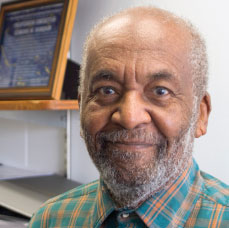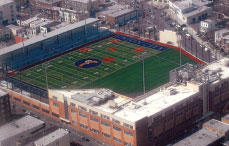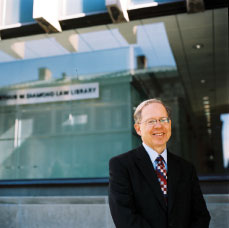Building The Village It Takes
There's no single solution to the achievement gap, but a lot of solutions, together, just might do the trick.
By Siddhartha Mitter
"America has become an outlier nation in the way we fund, govern and administer K--12 schools and in terms of performance. No other developed nation has inequities nearly as deep or systemic; no other developed nation has so thoroughly stacked the odds against so many of its children. Sadly, what feels so very un-American turns out to be distinctly American."
That damning assessment was issued in February by a bipartisan federal commission. But the problem it describes -'" the gap in academic achievement that separates poor students of color from their wealthier, primarily white peers -'" was first flagged in 1966 by the Equality of Educational Opportunity Study, better known as the Coleman Report.
Since then, "the gap" has been the focus of a seemingly endless series of reports and commissions.
Among the latest statistics that tell the tale:
- In 2010--2011, 76 percent of U.S. white students graduated from high school, compared with 60 percent of black and 58 percent of Latino students. In Ohio, the black-white gap was 26 percentage points; in Minnesota, it was 35.
- In math, the average African-American eighth-grader performs at the 19th percentile of white students. The average Hispanic student performs at the 26th percentile.
- Only one-third of eighth-grade students achieve more than mere proficiency in science. The average African-American, Latino, Indian, Native Alaskan and low-income student falls short of even basic achievement.
To a great extent, the achievement gap reflects greater inequities in American society. Nearly a quarter of U.S. school-age children live in poverty -'" twice the Organisation for Economic Co-operation and Development average and nearly four times that of leading countries, such as Finland. While the racial achievement gap has essentially remained constant over the years, the income achievement gap has grown by 40 percent since 1960.
While the gap as a recognized policy issue has been with us for more than half a century, the American vision of education as the great economic and social equalizer dates back to pre-Revolutionary War times, when John Adams argued for an education system to "raise the lower ranks of society nearer to the higher." Teachers College was created with precisely that purpose in mind, and -'" despite its name -'" in the belief that good teaching alone would be insufficient to the task. The birth of nutrition education, nursing education, education psychology and other fields at TC reflected the College's belief that children living in poverty could not learn unless their physical and emotional needs were met as well.
Over the years, Teachers College has sought to realize those goals, most notably by working through the channels of supplementary education and school finance reform. More recently, those two strategies have been combined with remarkable success in Union City, New Jersey, an overwhelmingly poor and Latino municipality where 90 percent of students graduate from high school. According to the commission that reported on the achievement gap in February, a 90 percent graduation rate for students of color would add $6.6 billion more in annual earnings to the American economy. The question is: Can Union City's success be replicated nationwide?
PART ONE: SUPPLEMENTARY "ED"
A longtime education warrior believes overcoming the achievement gap starts at home
Edmund Gordon, TC's Richard March Hoe Professor Emeritus of Psychology and Education, is one of the preeminent figures in psychology, education and social policy. Over seven decades, he has launched the first comprehensive social services clinic in Harlem, served as the founding research director of the federal Head Start Program, helped to write the Elementary and Secondary Education Act of 1965, created TC's Institute for Urban and Minority Education, and authored dozens of books and led scores of task forces. Below, in an essay adpted from an interview for TC's Oral History Project, he maintains that his vision of supplementary, or comprehensive, education -'" a range of supports and services designed to replicate the learning wealthier children receive through their families and communities -'" still offers the best hope for closing the gap.
My focus throughout my career has been on improving life chances for kids who were expected to fail. In the 1950s, in Harlem, my wife and I developed the Harriet Tubman Clinic for Children. She is a physician and I am a psychologist, so the focus was on health and guidance. But in time I became convinced that most problems kids ran into had more to do with their life circumstances than with internal psychic problems and that the most effective interventions would be through changing those circumstances.
In the late 1990s, I chaired the College Board's Task Force on Minority High Achievement. We had begun to take seriously the finding in Jim Coleman's work in 1966 that there was a systematic difference -'" a gap -'" in the academic achievement of black, Latino and poor folk compared to better-situated people. Prior to the 1990s, people had tried to ignore or deny that finding, because there were those who used it as support for the possible genetic origins of these differences.
But I had done research on black men who went on to high levels of achievement even though their early lives would have predicted otherwise. There were two factors that attracted my attention. These men had invariably had rich, out-of-school learning experiences that seemed to be complementing, or enabling, what they did in school. And there were people -'" family, church, fraternities, a wife -'" who were opening doors for them, who were helping them, who were orchestrating their development.
I was also influenced by having recently moved to the suburbs of New York, where I noticed that, invariably, the more privileged white families were doing for their kids what was almost accidentally or incidentally happening for my black high-achievers. Somebody out there was talking to them, was reading to them, was making sure their health problems were taken care of, was pointing them to a resource they ought to be using, was taking them to the museum or the library. So I put those two together and wrote a piece suggesting that one of the problems in the achievement gap was the difference in the kinds of support strata that come out of one's family and community, which some kids were getting and some kids were not. And it was more typical of black kids that they did not get those kinds of things.
So I convened a group of people to talk about it, and out of those talks came my book on supplementary education [Supplementary Education: The Hidden Curriculum of High Academic Achievement, 2004]. And supplementary education was very similar to what we had been trying to do in Harlem.
As I've gotten older, it's become clear to me that the U.S. political economy is contributing to the failure of education, because it's better at producing losers than winners. We've got almost 100 years of research showing that if you're poor, you're likely to do poorly in school, and if you're affluent or rich, you're likely to do much better. And that says to me that if society were really serious about it, we'd go after conditions of life as a way of boosting academic achievement. Of course, that means redistributing resources, and whenever I or anybody else talks about that, we get beat up as socialists. But I think it's where we're going to have to end up.
PART TWO: IT'S TIME FOR A MAKEOVER
Rethinking the education system, from top to bottom
Once upon a time, reformers hoped that learning standards could become a basis for recalibrating the entire education system, from performance targets to teacher prep to school financing.
That never quite happened (see story on page 42), but the new Common Core State Standards have prompted a group of reform-minded experts to once again ask: What if standards were used as a starting point to fix the entire school system? What if states figured out exactly what it would take to enable all students to perform up to the standards and then spent the money to accomplish the feat?
The answer, Michael Rebell suggests, is clear: We just might close the achievement gap.
Rebell, TC Professor of Law and Education Practice, served on a federal Equity and Excellence Commission that in February recommended those precise steps. In a report to U.S. Secretary of Education Arne Duncan, the Commission outlined strategies in five broad areas for ending disparities in educational opportunities and outcomes.
Topping the list is an overhaul of the nation's outdated system of school finance. Property taxes are still the primary source of school funding in many states, so towns with more taxable property "can fund their schools more generously and at lower tax rates." Some states and districts spend two to three times more per pupil than their poorer counterparts, and more than 40 percent of all American public school children are enrolled in districts of concentrated student poverty.
The report calls for states to identify and "cost out" all services that create "meaningful educational opportunity," adopt and monitor school finance systems that provide those services, and periodically update finance systems to respond to new standards and research about learning.
But with states still reeling from the 2008 fiscal crisis, the authors also want the federal government to kick in more than its current 10 percent share of national K--12 spending and press states to enforce efficiency. They also call for sweeping changes to bring American teaching and schools on par with that of the world's top-performing nations, including boosting average starting teacher pay from $37,000 to $65,000 and top salaries from $70,000 to $150,000.
Conceptualizing the overhaul of an entire school system is daunting work, but Rebell has done it before. As the lead attorney in a 13-year school-finance lawsuit that won a multi-billion-dollar verdict for New York City's public schools, he argued that the state, having already set specific learning standards, was obligated to provide students with the resources to achieve them. When the courts challenged Rebell for specifics, he convened teachers, administrators, parents and students to determine what resources were needed and how much they would cost.
Since the 2008 fiscal crisis, Rebell has pursued a different strategy. In 2011, he spearheaded the campaign and forum "Achievable and Affordable: Providing Comprehensive Educational Opportunity to Low-Income Students." The effort proposed a legal framework for providing the country's neediest children with both improved educational resources and other wraparound services, including health care and after-school programs. It also detailed the cost of providing those services and projected the return on such an investment.
"You have to think long-term," Rebell says, explaining his never-say-die attitude. "You put the models for change out there, you keep the pressure on, and when the right moment comes, you've got a remedy that politicians can use. That's what happened with the school finance case. No one gave us much of a shot, but in the end, we won. Now we're trying to show that you can fully and cost-effectively implement children's rights to a sound basic education in a changed economic climate. I think we can do it."
PART THREE: THE PICTURE OF SUCCESS
An unlikely academic superstar, Union City, New Jersey, has much to teach us
The first thing David Kirp wants you to know about Union City, New Jersey, is that it's not Camden. "Camden is a scary place with 27 bars and no grocery stores," Kirp told a Teachers College audience in March. Union City, by contrast, is "a vibrant Latino community," once known as "Havana on the Hudson" and now home to people from across Central and South America.
Twenty-five years ago, Union City did resemble Camden in one unhappy particular: both cities' education systems were so dysfunctional that the state was threatening to take them over. The state recently did so in Camden, but today Union City -'" with a population that is one-fourth undocumented immigrants and with nearly all its students eligible for free or reduced-price school lunch -'" boasts a 90 percent high-school graduation rate. That's 15 percent higher than the national average.
How are they doing it? Kirp, a former Sachs lecturer at TC who teaches public policy at the University of California at Berkeley, spent a year on location trying to find out.
"The story of how this place succeeded is one that any educator with a pulse will understand," he said in discussing his new book on Union City, Improbable Scholars: The Rebirth of a Great American School System and a Strategy for America's Schools (2013). It's a matter of "a few well-demonstrated, well-proven, evidence-based ideas, which you persist in improving and tweaking at the margins. And they didn't change overnight."
The "well-proven ideas" include two years of full-day preschool for all students; a bilingual program for younger kids that grounds them in Spanish and transitions them to English; "port-of-entry" classes for older, non-English-speaking children that immerses them in Spanish and English as a Second Language before bringing them into mainstream English literature courses by their senior year; low-stakes assessments that are used "to pinpoint places where students and teachers need help"; and an intensive parent-engagement program that distributes materials in Spanish and employs Spanish-speaking community liaisons.
Kirp says that similar strategies are employed, in varying forms, in other successful school systems. Still, he concedes that Union City enjoys two unique advantages. One is New Jersey's 30-year education finance lawsuit, Abbott v. Burke, which has brought billions of additional dollars to the state's poorer schools and established court-ordered universal preschool.
"The court said to the private for-profits, the churches, the baby-sitting places where an abuela [grandmother] would take care of the kids, -'You've got to have people with college degrees and training in child development,'" Kirp recounted. "The colleges sent teachers and professors to the preschools to work at night and on weekends with those teachers. In places like Union City that knew how to take advantage of Abbott, they now have 35 preschools -'" places where you'd be totally happy to have your kids."
In fact, Union City has now exported its preschool model upward through the grades. "Now you go into the kindergarten classes, and instead of looking like the new first grade, with kids sitting in rows and call-and-response teaching, they look like pre-K classes for kids who are slightly older. And all those wonderful things that are first nature for preschool teachers -'" cross-disciplinary projects, students moving around classrooms, working in groups -'" are working their way up, so you even see it in high-school classes in really interesting ways."
Union City also benefits from its fascinating political calculus. The mayor, Brian Stack, is also a state legislator and despite being a Democrat counts New Jersey's Republican governor Chris Christie as a close political ally. Stack "brings in the bacon," Kirp says, and the benefits are evident. Union City recently built a showpiece high school with a stunning sports complex, science labs that "Columbia would be happy to trade for" and a curriculum that includes three years of Chinese. Even more important is a climate of stability and continuous improvement created by the "virtuous circle" of trust between a mayor who provides and a school system that performs. While that balance might be harder for other municipalities to replicate, Kirp said, it illustrates what's possible under ideal conditions.
"You don't have the classic three-year churn," he says, "where the school board picks a superintendent who promises miracles, the miracles don't happen fast enough, insurgents campaign to get the bums out of there and then put in another superintendent who's bound and determined to throw out everything the predecessor did."
This June, Kirp says, two of the top 10 students in Union City High School's 620-member graduating class are immigrants "who came to this country four years ago not speaking a word of English.
"When I talked to those kids, they rattled off the names of the organizations they were not just members of but were officers in," Kirp said. "Their peers in the Future Business Leaders of America don't know about political correctness and how cool it would be to have an immigrant kid who's president of this organization. All they know is, here's a kid and he's the best we've got."
Published Thursday, Jun. 27, 2013


